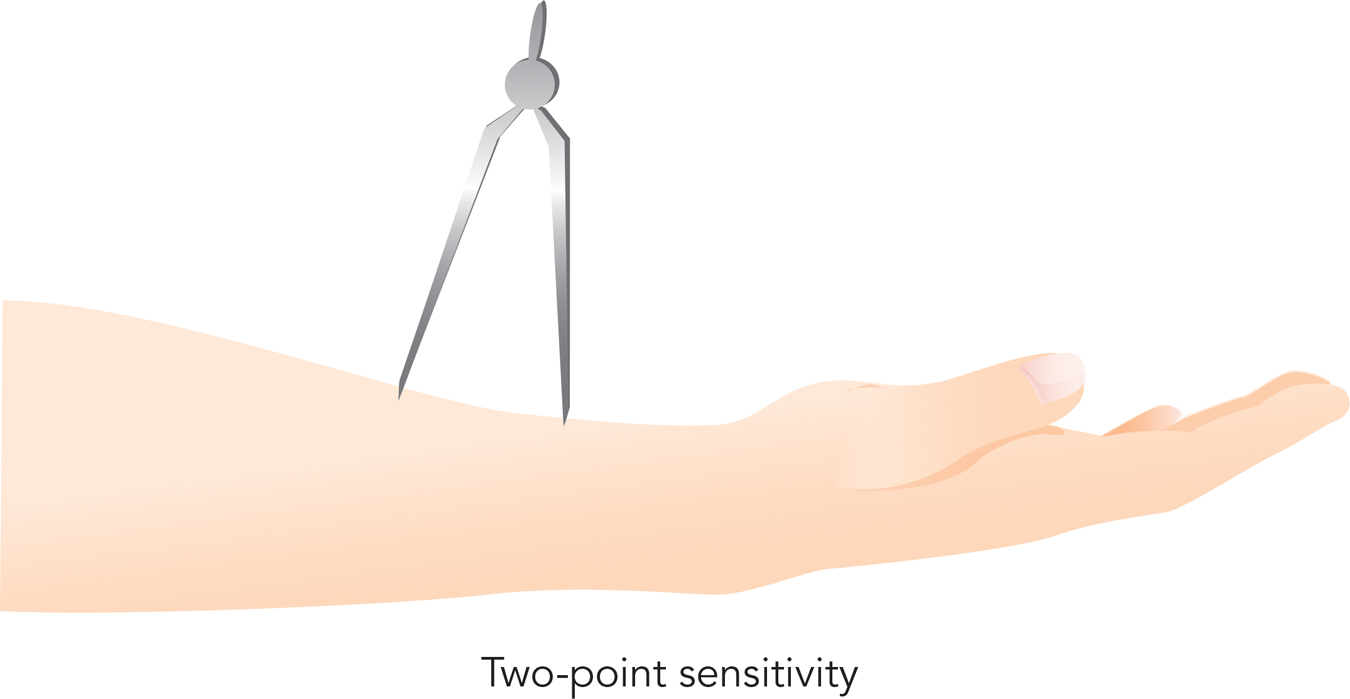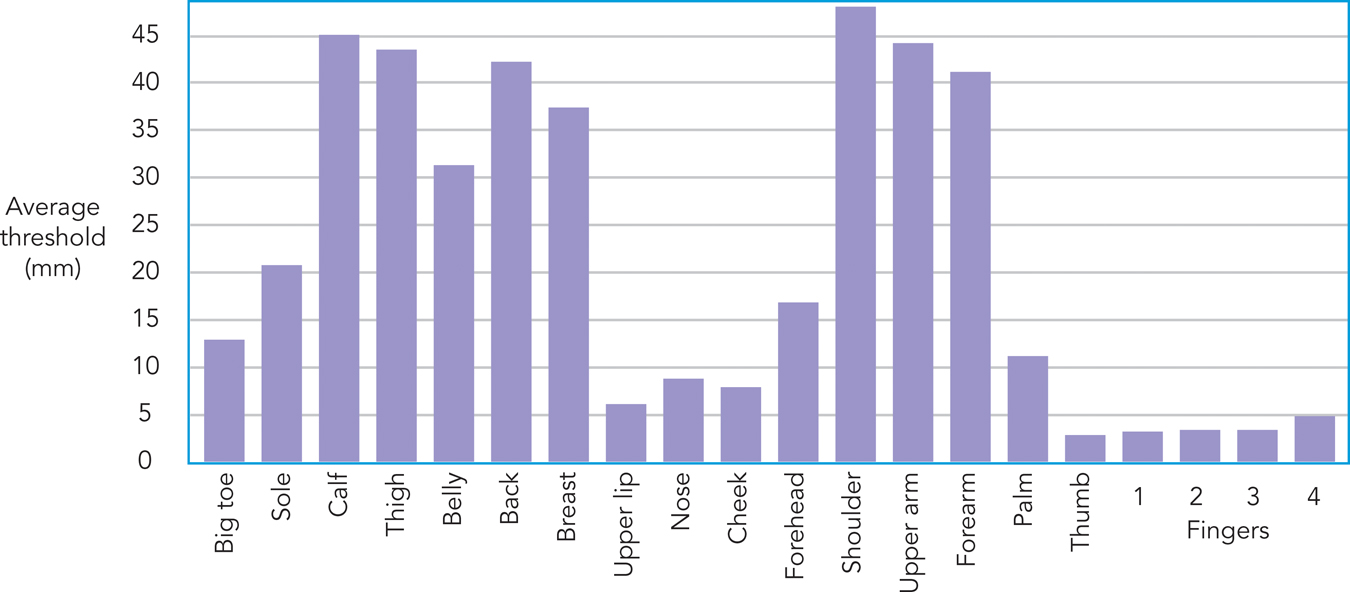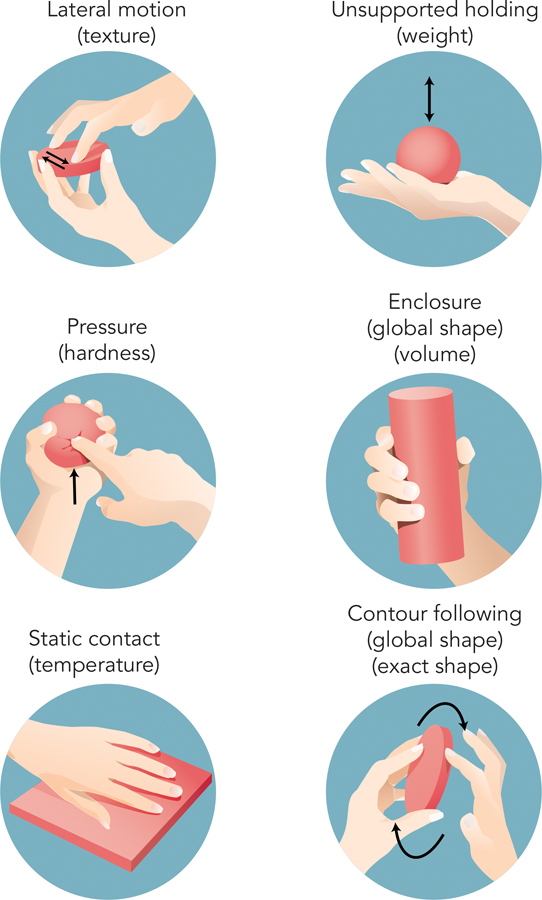5.7 The Haptic System
Try this. Close your eyes and ask a friend to hand you an everyday object. What can you learn about the object without even looking at it (or listening to or smelling it)? A lot! You’ll quickly acquire a wealth of information: its size … its shape … what it’s made of. You might even be able to identify exactly what the object is.
This information comes through your haptic system, the perceptual system through which people acquire information about objects by touching them (Lederman & Klatzky, 2009). (The word haptic comes from the Greek word for “touch.”)
Not all types of touch are the same. As James J. Gibson (1962) pointed out, there are two types:
Active touching: Sometimes you touch an object. You purposefully explore it to learn about its properties.
Being touched: Sometimes objects touch you. They variously bump, scratch, or rest gently upon the surface of your skin.
The two types of touch differ psychologically. Through active touching, you perceive physical properties of objects in the environment—
In this section of the chapter, we’ll first look at the types of information you acquire by using your haptic system. After reviewing these psychological processes, we’ll move down to a biological level of analysis, to learn about the nervous-
Haptic Perception
Preview Questions
Question
 On what parts of the body is touch perceived most accurately?
On what parts of the body is touch perceived most accurately?
Question
 How do hand and finger movements deliver information about texture, temperature, and hardness?
How do hand and finger movements deliver information about texture, temperature, and hardness?
Question
 How do we detect mass?
How do we detect mass?
Let’s first look at the precision, or acuity, of the haptic system. We’ll then see how this system reveals information about (1) the surfaces of objects (their texture, temperature, and hardness), and (2) objects’ size and shape.
ACUITY. If somebody taps you, you can locate the tap: It was felt on your arm, or shoulder, or head, or back. How precisely can you locate it, though? This is a question about the acuity of the haptic system, that is, the accuracy with which the system can identify whether it has been stimulated, where the stimulation has occurred, and the number of stimulations that occurred.
Researchers have developed psychophysical procedures to measure haptic system acuity. A classic method is the two-
Have you ever had trouble finding an itch on your back?

A key finding is that the two-

SURFACES: TEXTURE, TEMPERATURE, AND HARDNESS. The haptic system delivers information about the surfaces of objects. The type of information received depends on how you explore the surface. Different types of hand and finger movements deliver different types of information (Figure 5.45).

When you move your fingertips back and forth across the surface of an object, you acquire information about texture—
Touch also provides information about temperature. When holding your fingers still on an object’s surface, you usually find that the object feels slightly cool. The surface temperature of your skin is similar to the inner temperature of your body, which is warmer than most indoor and outdoor environmental temperatures, so the object in the environment feels cool.
The temperature of objects can affect other judgments. When people touch two objects and try to identify whether they are made of different materials, the objects’ temperatures affect people’s identification. It is harder to identify differences between materials if they are heated to the same temperature (Lederman & Klatzky, 2009).
A third surface property you perceive haptically is hardness. Pressing against an object’s surface—
SIZE AND SHAPE. The haptic system also delivers information about an object’s size and shape. Exploring an object by touch with your eyes closed, you can identify its approximate length and width. By holding the object and moving it around, you can estimate its mass (weight).
A principle you learned earlier, in the section on the visual system and brightness, applies also to the haptic system and perception of mass. You can apply that principle here to answer the following question: How big a difference in physical mass is required for the haptic system to detect that the mass of an object has changed? The principle of just noticeable differences is that there is no single, fixed answer to that question. If somebody hands you two envelopes, one weighing 1 ounce and the other 2 ounces, you’ll notice the difference. If somebody hands you two dumbbells, one weighing 24 pounds, 15 ounces, and the other 25 pounds, you won’t notice. The smallest detectable difference increases as the mass of objects increases.

Like other perceptions, the perception of mass is subject to illusions. For example, when judging the weight of two objects that weigh the same but are of different sizes, size influences weight judgments: Larger objects are perceived as lighter. Even with practice lifting the objects, people judge that smaller objects are heavier than larger ones when the objects are, in reality, the same weight (Flanagan & Beltzner, 2000).
Are you surprised that people will judge the smaller of two equal-
WHAT DO YOU KNOW?…
Question 15
True or False?
Using the two-
point procedure, scientists have learned that the greatest haptic acuity is found at the back. A. B. As the mass of two objects increases, it becomes more difficult to detect small differences in weight between them.
A. B.
From Skin to Brain: Biological Bases of Haptic Perception
Preview Question
Question
Question
 Through what biological process are we able to convert haptic information from our skin to our brains?
Through what biological process are we able to convert haptic information from our skin to our brains?
Let’s now look under the skin—
The body contains, underneath the skin, cutaneous receptors, which are receptor cells that convert physical stimulation into nervous-
Breadth: Some receptors (such as those in the fingertips) respond to stimulation in a specific narrow area of the skin’s surface, whereas others respond to a broader area of stimulation.
Speed of adaptation: After the skin is stimulated, some receptors return quickly, and others more slowly, to their original firing rate (Lederman & Klatzky, 2009).
These differences produce different types of sensatory experience. Pricking your finger with a pin feels different from pressing on the side of your hand because the two types of stimulation activate different types of receptors.
One distinct type of cutaneous receptor responds to changes in temperature. It transduces physical temperature into neural signals that lead to the experience of hot and cold.
WHAT DO YOU KNOW?…
Question 16
We have different types of receptors, which respond to stimuli in two different ways. Some receptors have greater or lesser of response, referring to how much of the skin needs to be stimulated, and some have greater or lesser of adaptation, referring to how long it takes for the receptors to return to their original firing rate.
The Kinesthetic System
Preview Question
Question
 What is our sixth sense?
What is our sixth sense?

Imagine you’re playing the game Twister, all twisted up after a few moves. Now imagine that the only lamp in the room falls over and hits you on the head, plunging you into darkness and causing you temporarily to lose memory of the fact that you’re playing Twister. Even though you can’t see your arms and legs, and don’t remember moving your hands and feet to the various colored circles, you still know you’re twisted up. You can feel it.
This feeling comes from your kinesthetic system, the perceptual system that delivers information about the orientation of your body and its various parts. A key source of these signals is nervous system inputs coming from your muscles. Even when signals from the skin and bones are blocked (e.g., through anesthesia), people are aware of the position of their limbs thanks to information coming from the muscular system (Matthews, 1982). This indicates that kinesthetic feedback from muscles is a unique perceptual system.
Brain-
THINK ABOUT IT
Ever since grade school, you probably have been taught that there are “five senses”: sight, hearing, taste, touch, and smell. But are there only five? What if you were weightless, in outer space? You’d immediately know you were weightless. What “sense” would tell you that?
In addition to nervous system input from muscles, another biological mechanism that contributes to kinesthetic abilities is the vestibular system, found within the inner ear. The vestibular system contains small fluid-
With your eyes closed, can you touch your finger to your nose? You have your kinesthetic sense to thank.
WHAT DO YOU KNOW?…
Question 17
Upon waking up, even before opening your eyes, you know exactly how your body is positioned because of processing in the system.